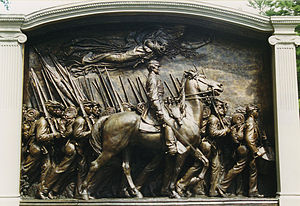I’m more than half Southern on my mother’s side, but I grew up (and have lived most of my life) in Massachusetts, so until pretty recently I was able to think of Confederate statues as mostly a matter of heritage and history.
Next to her writing desk my Richmond-born grandmother had a World War I recruiting poster that depicted an avuncular gray-uniformed General Robert E. Lee and the words “I FOUGHT FOR VIRGINIA. NOW IT’S YOUR TURN.” (The same slogan was used during World War II, inviting civilians to join the Lee Navy Volunteers.)
My grandmother’s middle name before she married was Washington. She was also a descendant of Custises and Lees. My New England born and bred father was a collateral descendant of Robert Gould Shaw, first commander of the 54th Massachusetts, who was killed in action and didn’t live long enough to leave direct descendants. My father, Robert Shaw Sturgis, was named after him.

The Bonnie Blue Flag, the first unofficial flag of the Confederacy
Having both sides of the Civil War in my ancestry seemed a natural state of affairs. As I and my three siblings entered the world, my grandmother, who played piano by ear, gave each of us a song. Mine, of course, was “Oh, Susannah!” Brother Roger’s was “Dixie,” brother John’s was “Maryland, My Maryland” (he was named after Marylander John Hanson, the first person to serve a one-year term as president under the Articles of Confederation), and sister Ellen’s was “The Bonnie Blue Flag.”
My grandmother was almost certainly the source of two LPs I played so incessantly as a kid that I learned most of the songs by heart: Tennessee Ernie Ford Sings Songs of the North and Tennessee Ernie Ford Sings Songs of the South. Both albums were released in 1961, the centenary of the Civil War’s beginning, when I was 10. That’s probably when they came into my family’s home in the Boston suburbs. (They’re both available on CD these days, separately and as a two-CD set.)
Above the mirror in my grandmother’s dining room was a small Confederate battle flag with a rustic wood frame. As the years went by and I learned more about the Civil War and more about Jim Crow, as the antiwar movement brought me into contact with veterans of the civil rights movement, that flag would grow huge in my mind’s eye until it was bigger than the mirror and dominated the wall. Every time I returned to my grandmother’s house — which was pretty often, since she lived less than 10 miles away from my parents — I was startled by how small that flag was.
On Martha’s Vineyard the trappings of the Confederacy are rarely seen, and the few swastikas I’ve seen in the last 30-plus years have all been graffiti. Ugly as they are, swastikas chalked on brick walls don’t have the visceral impact of the Nazi flags carried in Charlottesville. So my belief that the statues were mostly about history and heritage was rarely challenged. When it finally was, it collapsed completely.
Writes historian Karen L. Cox:
Almost none of the monuments were put up right after the Civil War. Some were erected during the civil rights era of the early 1960s, which coincided with the war’s centennial, but the vast majority of monuments date to between 1895 and World War I. They were part of a campaign to paint the Southern cause in the Civil War as just and slavery as a benevolent institution, and their installation came against a backdrop of Jim Crow violence and oppression of African Americans. The monuments were put up as explicit symbols of white supremacy.
Cox also notes that “the group responsible for the majority of these memorials was the United Daughters of the Confederacy (UDC), among the most influential white women’s organizations in the South in the late 1800s and early 1900s,” and to which I believe my grandmother belonged. The World War I recruiting poster by my grandmother’s desk would have come from the tail end of this period.
 In contrast, a monument to Robert Gould Shaw and the 54th Massachusetts stands outside the Massachusetts statehouse on Beacon Hill. It was erected in 1884. It’s a tourist attraction, but it hasn’t been a rallying point for any political perspective, not even after the 1989 film Glory made the 54th Massachusetts famous.
In contrast, a monument to Robert Gould Shaw and the 54th Massachusetts stands outside the Massachusetts statehouse on Beacon Hill. It was erected in 1884. It’s a tourist attraction, but it hasn’t been a rallying point for any political perspective, not even after the 1989 film Glory made the 54th Massachusetts famous.
In the wake of Charlottesville, a vigil and a rally were held a week apart on the Vineyard. Both took place at the Civil War monument across from the ferry terminal in Oak Bluffs. The monument is easy to miss, even once you know it’s there. Its surprising history is told in Tom Dunlop’s “Uniting the Divided” on the Martha’s Vineyard Magazine website, but these pieces of it stand out:
Charles Strahan, who raised the funds for the monument, was by then a newspaper editor on the Vineyard. A native of Maryland, he had fought for the Confederacy. The monument honored the Grand Army of the Republic. It was dedicated on August 13, 1891. Are you feeling a little dissonance yet?

The fourth inscription, 1925
Inscriptions on three sides honored the Union army and its Vineyard combatants. The fourth side was blank until 1925, when an inscription was added, funded by the surviving veterans of the Grand Army of the Republic. This had been Strahan’s hope from the beginning, and he was alive to see it dedicated on September 4, 1925. It reads:
“The chasm is closed.”
In memory of the restored Union this tablet is dedicated by Union veterans of the Civil War and patriotic citizens of Martha’s Vineyard in honor of the Confederate soldiers.
Noting the 34-year gap between the two dedications, and wondering how many Union army veterans were still around in 1925, 60 years after the end of the war, I wonder if there was resistance to the idea of honoring the Confederate soldiers. The chasm between North and South was alive and well in 1925 for those who cared to look; the Great Migration of African Americans from South to North was well under way. I suspect that on some level at least, the chasm was within Charles Strahan himself, a man who had fought for the Confederacy but had lived on Martha’s Vineyard since 1884.
After the passing decades had taken their toll, the monument was restored in the late 1990s and rededicated on August 17, 2001.
At the “rally for unity” last Sunday, there was some talk about the statue, and about that fourth inscription. Was this monument problematic? Should it be taken down? Why would anyone want to honor the Confederate soldiers?
I’m not a big fan of statues, but I like this one. It embodies the complexity and contradictions of both the Civil War and our often dis-United States. It makes me look at history from different angles. It reminds me that my grandmother had Robert E. Lee and the Confederate battle flag in her dining room, and that I still know the words to a bunch of Confederate songs.

A Union infantryman, Oak Bluffs


Context matters.
LikeLike
I spent some time growing up in the South, arriving with NO opinion of the statues and leaving with a poor one. Far too many times it was hissed in my ear that the South Will Rise Again, which drove home the point to me that the war was also about a state’s “right” to secede from the union if it took issue with governance. Seeing the constant over-romanticizing of Southern history is disturbing, for while like the general German population during World Wars I and II, the average person had little control over the way things were, glorifying a way of life now that denigrated anyone not of the white ELITE class of landowners is just not palatable. Based on my experiences there in the 1970’s, I thought I would never live to see the day when the statues would be removed. I am so pleasantly surprised to see that those voices I heard in the 1970’s did NOT belong to the progressive, modern South.
I do think it is important that we not forget our history, that we remember the question not only of Civil Rights (but also what profoundly shaped those rights by way of states rights and secession) were asked, challenged and resolved by that terrible war. A tragic price was paid by many a soldier and the commoner alike. However statues are about remembering and honoring those they represent. The proper place for honoring an attempt to divide our country should not be in our town squares, but in our museums and cemeteries, where the COST of such hubris is properly couched in the reality and lens of history past.
LikeLike
Susanna, on a similar but side note, I sing “This Land is Your Land” with my preschoolers. But, I sing all six verses (most people only know the first three). Pretty controversial, but of course the children LOVE the song.
LikeLiked by 1 person
My favorite is the one about the “no trespassing” sign. 🙂 I wish the one about the relief office were much better known than it is. I’m glad you’re singing them all!
LikeLiked by 1 person
Me, too Susanna!
LikeLike
What a powerful post. Like you, I have deep southern roots. I think much of the statue removal today is sad. Here’s why: for the most part, when people encounter a statue, it is a trigger for a history discussion. Regardless of what side you were/are on in history, it is there. And that means learning. Learning the good and bad, the right and wrong. It feels like we’re book banning right now. Also, these statues are remarkable pieces of art. Sometimes people who walk by statues see it for the art. That’s a good thing, too.
LikeLiked by 1 person
I’m with you -I’m not a fan of statues, they have always been men as are most buildings named after people(men). I shook Andrew Young’s hand the other night when I was walking in to the restaurant at Farm Neck. I said “Andre Young right? He said yes I am and I shook his hand and I said I admired him.” As I was walking away he said to someone with him “Oh she’s old enough to know me”, which I chuckled at. Anyway ironically I was driving to work this morning listening to NPR ( what else is new) and they were interviewing him about the statue issue and he felt strongly that it was a distraction from bigger issues,that we should add a bell to all of them, as MLK said “let freedom ring.”
LikeLiked by 1 person
On one hand, I think a lot of privileged people in the left of center are making a fetish of the statues — which is more or less the flip side of what the right is doing. On the other, being surrounded by monuments to Confederate generals makes me think of being buried in books by white men, with nary a clue that any other words were out there or why they might be missing. I like Andrew Young’s idea — “If I had a bell, I’d ring it in the morning . . .”
LikeLike